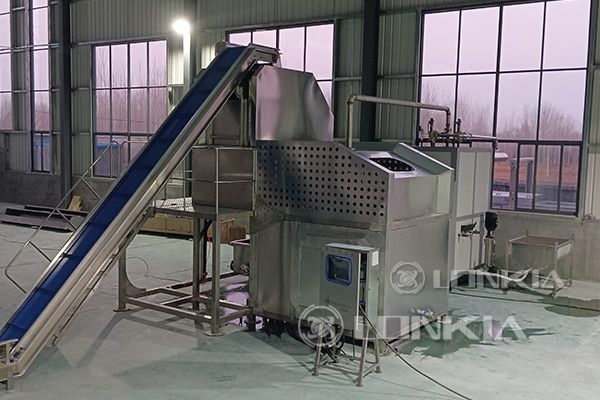The peeling process is one of the most critical steps when processing large quantities of potatoes, and how it’s performed can have a drastic impact on yields, the amount of peel removed, and the finished texture of the peeled product. A key consideration is the ability to remove the desired amount of peel without losing too much good flesh underneath.
Read on to learn more about steam peelers vs. abrasive peelers for peeling potatoes when processing fries.

How Do Steam Peelers Work?
Many potato processing facilities use steam peeling when 100% peel removal is required. The process works by adding the potatoes into a rotating pressure vessel and exposing them to high pressure steam.
This high pressure steam heats the water beneath the skin of the potato. When the pressure is then released from the vessel, this water rapidly expands and loosens the peel from the flesh of the potato.
Typically, the potatoes are then fed into a separate machine that scrubs away the loosened skin.
Steam Peeler Advantages
The biggest selling point for steam peelers is that you can more easily achieve a 100% peel removal rate. You can get much more skin off the potato with lower yield losses than an abrasive peeler.
Steam Peeler Disadvantages
The main downside to a steam peeler is the initial investment and upkeep. You need to invest heavily in infrastructure and utilities around the machine to generate the pressure/steam required for the peeling process. You’ll also need a way to depressurize the vessel and release the steam.
How Do Abrasive Peelers Work?
There are several different types of abrasive potato peelers, but they all work similarly. Potatoes are fed into a bed of rotating abrasive rolls. The abrasive surface of the rolls peels the potatoes both directly--by rubbing against the skin of the potatoes--and indirectly--by generating a tumbling motion in the bed that forces the potatoes to rub against one another. Water is then used to flush the peel waste from the bed.
Abrasive Peeler Advantages
Abrasive peelers are ideal for applications that don’t require a 100% peel rate, and they also don’t create a “cook ring” that occurs when using a steam peeler.
Abrasive peelers are also very flexible and can wash and scrub potatoes too. The aggressiveness of the rolls, speed of the rolls, and bed depth can be adjusted to remove caked-on mud and dirt or to achieve the desired level of peel removal.
They are also generally much cheaper to purchase and easier to maintain. They're available as batch machines or continuous — continuous allows for more throughput and consistent results throughout a production run.
Abrasive Peeler Disadvantages
A disadvantage to abrasive peeling is that in order to achieve 100% peel removal, it takes much more time and much higher yield losses compared to steam peeling. Most often, when 100% peel removal is a requirement for the end product, processors use a hand trimming process to remove the remaining peel that the abrasive peeler did not get.. The surface of the potato is often uneven and an abrasive peeler has to grind down all of the "high spots" in order to remove the peel in the "valleys" of the potato's surface.

